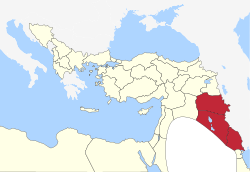
Back مماليك العراق Arabic Məmlük sülaləsi (İraq) Azerbaijani مملوک خاندانی (عراق) AZB مەمالیکی عێراق CKB Gobierno mameluco en Irak Spanish ममलूक राजवंश (इराक) Hindi イラクのマムルーク朝 Japanese მამლუქთა დინასტია (ერაყი) Georgian 이라크 맘루크 왕조 Korean ممالیک عراق PNB
This article needs additional citations for verification. (December 2023) |
Mamluk dynasty of Iraq مماليك العراق Mamālīk al-ʻIrāq | |||||||||
|---|---|---|---|---|---|---|---|---|---|
| 1704–1831 | |||||||||
 Approximate area under Mamluk rule. | |||||||||
| Status | Nominally part of the Ottoman Empire | ||||||||
| Capital | Baghdad | ||||||||
| Common languages | Ottoman Turkish, Iraqi Arabic | ||||||||
| Religion | Sunni Islam (majority), also Shia Islam (In Najaf and Karbala),[1] Christianity, Mandaeism, Judaism | ||||||||
| Government | Pashalik (autonomous) | ||||||||
| Pasha | |||||||||
• (1704–1723) | Hassan Pasha | ||||||||
• (1816–1831) | Dawud Pasha | ||||||||
| History | |||||||||
• Dynasty formed | 1704 | ||||||||
| 1831 | |||||||||
| |||||||||
| Today part of | Iraq | ||||||||
The Mamluk dynasty of Mesopotamia (Arabic: مماليك العراق, romanized: Mamālīk al-ʻIrāq) was a dynasty of Georgian Mamluk origin which ruled over Iraq in the 18th and early 19th centuries.[2][3]
In the Ottoman Empire, Mamluks were freedmen who converted to Islam, were trained in a special school, and then assigned to military and administrative duties. Such Mamluks presided over Iraq from 1704 to 1831.
The Mamluk ruling elite, composed principally of Georgian and Circassian origin from Caucasian officers,[4][5] succeeded in asserting autonomy from their Ottoman overlords, and restored order and some degree of economic prosperity in the region. The Ottomans overthrew the Mamluk regime in 1831 and gradually imposed their direct rule over Iraq, which would last until World War I, although the Mamluks continued to be a dominant socio-political force in Iraq, as most of the administrative personnel of note in Baghdad were drawn from former Mamluk households, or comprised a cross-section of the notable class in Mamluk times.[6]
- ^ Nieuwenhuis, Tom (1981). Politics and Society in Early Modern Iraq: Mamlūk Pashas, Tribal Shayks, and Local Rule Between 1802 and 1831. Netherlands: Springer Netherlands. p. 31. Retrieved 12 March 2024.
- ^ The Rise and Fall of the Communist Party of Iraq, Tareq Y. Ismael, I. 1.
- ^ A Military History of Modern Egypt: From the Ottoman Conquest to the Ramadan War, Andrew James McGregor, p57
- ^ Hathaway, Jane; Barbir, Karl (2008). The Arab Lands under Ottoman Rule: 1516-1800. Pearson Education. p. 96. ISBN 9780582418998.
- ^ Hathaway, Jane (February 1995). "The Military Household in Ottoman Egypt". International Journal of Middle East Studies. 27 (1): 39–52. doi:10.1017/s0020743800061572. S2CID 62834455.
- ^ Cite error: The named reference
HMFwas invoked but never defined (see the help page).